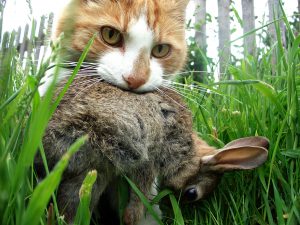Whether you’ve gotten a kitten or an adult cat, we hope that these tips will come in handy for you:
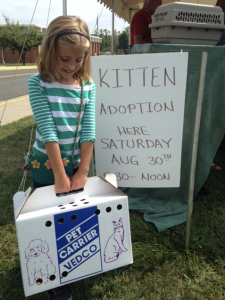 Nothing’s more fun than a new kitten, and we know you’ll have a blast. However, there are some things that we feel are sometimes not well communicated to new cat owners about the long term care of cats that could help you make your kitty’s life as long and healthy as it could be, as well as helping you to avoid behavioral issues in the future.
Nothing’s more fun than a new kitten, and we know you’ll have a blast. However, there are some things that we feel are sometimes not well communicated to new cat owners about the long term care of cats that could help you make your kitty’s life as long and healthy as it could be, as well as helping you to avoid behavioral issues in the future.
We might be called Green Dog, but the owners and staff of Green Dog are actually made up of some pretty serious cat people. We know there’s a lot of info in here, especially in the diet section, but after serving the cat community of Portland since 2004, our hearts are often heavy from the overwhelming numbers of cats with chronic illness, much of which we feel could have been prevented with better nutrition. Also, a greater understanding of the behavioral needs of cats could help to prevent or resolve behavioral issues that are very difficult for the humans in the household to live with and often result in cats being given up to shelters.
Food:
We are lucky to live in a time and in a town that has a tremendous selection of ways to  nourish your cat. Food is the absolute cornerstone of health, for us and for our cats. Many foods will allow your cat to survive, but the quality, types of ingredients, and the amount of processing a food goes through matter quite a bit. These factors can often be the difference between surviving and thriving.
nourish your cat. Food is the absolute cornerstone of health, for us and for our cats. Many foods will allow your cat to survive, but the quality, types of ingredients, and the amount of processing a food goes through matter quite a bit. These factors can often be the difference between surviving and thriving.
Most people automatically pick up a kibble for their new cat, but we’d like to let you know that there are other options as well. Kibble is of course very convenient, and kitties like it a lot. In our opinion, kibble has come a long way in the past 10 years or so and some are much better than others (later in this article, we’ll tell you how to identify the good from the bad). However, this is still a highly processed form of food, and as many people realize that for our own health, the less processed food and the more whole food in our diets, the better. The greater problems with kibble for cats are that many are too heavy in carbohydrates for cats, and also that kibble is so moisture deficient. Meat and Moisture are the two cornerstones of good nutrition for cats. There are some great moisture-rich cans and excellent commercially prepared diets made with fresh, minimally processed foods on our shelves and freezers, and we encourage you to try to integrate them, at least in part, to your cat’s diet. (You could of course make their food, though we realize that not everyone has the time or inclination to make their cat’s diets. If you want to, check out www.catinfo.org, written by a vet or www.feline-nutrition.org for lots of tips and instructions). Regardless of how you provide it, we’d like to tell you why meat and moisture are such valuable components of the health of cats.
We talk to so very many customers who have cats with renal failure, urinary tract problems, diabetes, and serious bowel problems. Understanding a few things about how cats are designed and what their nutritional needs are will help you make better choices for your cats to avoid these problems which are often so rooted in nutrition (and so expensive to deal with once they have them!)
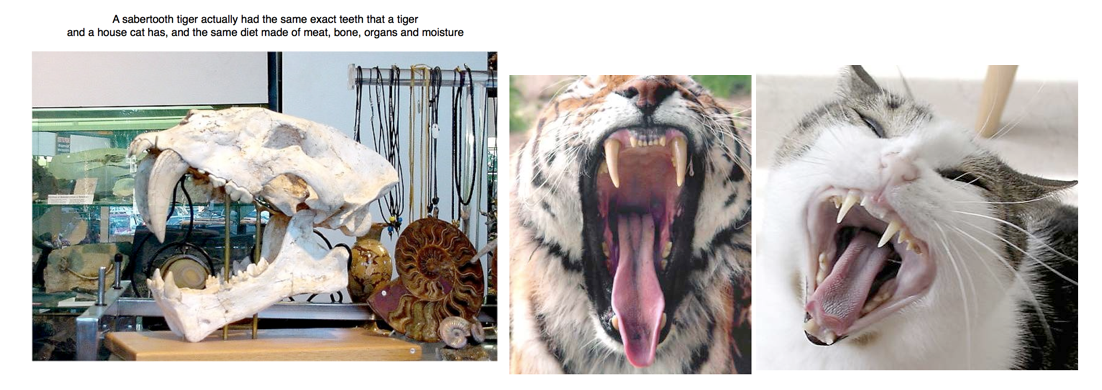
Diet:
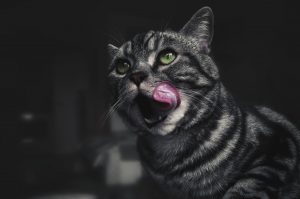 First, cats are obligate carnivores, and are designed inside exactly like their wild counterparts. The term “Obligate carnivores” means that, unlike coyotes or dogs that can be more opportunistic and take advantage of many different varieties of foods that they find, scavenge or hunt, house cats (and tigers and leopards) are specifically designed to eat a diet made up of fresh meat, bone, organs and the moisture that accompanies them.
First, cats are obligate carnivores, and are designed inside exactly like their wild counterparts. The term “Obligate carnivores” means that, unlike coyotes or dogs that can be more opportunistic and take advantage of many different varieties of foods that they find, scavenge or hunt, house cats (and tigers and leopards) are specifically designed to eat a diet made up of fresh meat, bone, organs and the moisture that accompanies them.
Make sure foods are made with a very high percentage of meat and avoid foods abundant in starches (grains, legumes, potatoes, etc). Cats were not designed by Mother Nature to make very good use of plant based proteins, as they lack specific metabolic (enzymatic) pathways that would allow them to use plant proteins efficiently. A diet low in quality meat proteins contributes to many chronic illnesses in cats. In fact, studies have shown a strong link between high carb diets and urinary tract disease. In a discussion of feline heart disease, Dr Karen Becker, DVM says, “I firmly believe the unnecessary carbohydrates found in most cats foods offsets the amount of protein cats need, making carbs a significant nutritional contributing factor to feline heart disease. The amount of taurine, carnatine and CoQ10 found naturally in unprocessed meat is critically important to feline heart health. In my opinion, these vital nutrients are not found in adequate quantities in most dry foods, and processing further diminishes their bioavailability. This is another reason I recommend starch free foods (no grains or potatoes) for cats.” Note that all kibbles must contain some amount of starchy carbs to hold it together and make those little crunchy bites. There are definitely some better kibbles, meaning those that are meatier with fewer carbs than others. “Grocery store” kibbles are especially inappropriate for cats, as almost all of the protein in these foods is derived from plants like corn and wheat (as they are far less expensive than animal based proteins), with some meaty flavorings and meat by-products. Corn is an extremely high glycemic food – each time they eat it their blood sugar spikes, and a lifetime of this sort of food could lead to diabetes. Carbs also create weight gain for cats instead of energy – a meatier diet will keep them leaner and more satiated with a smaller amount of food.
Moisture
:
Another very critical component of cat food is moisture. In fact, if there’s one single aspect we would identify as most important in cat food to help avoid many common chronic illnesses of the urinary tract and kidneys, it would be moisture content. Cats have not had to evolve a very strong thirst drive, as their natural prey contains quite a bit of moisture. In fact, many carnivores in nature derive most or all of their moisture from the prey that they eat. A mouse or a bird is about 75% moisture, similar to the moisture content of canned and raw foods. Cats on dry foods will appear to drink more water than cats on cans or raw, but if you add the amount of moisture in a kibble (about 10%) to the amount that they drink, they still are usually consuming only about 1/2 of the moisture they would be getting from a moisture-rich diet. This can lead to a state of chronic low-level dehydration, which over a lifetime can lead to stress on the kidneys. We have so many customers whose cats have kidney problems that we’ve actually had to come up with a special system in our food room to make it easier for owners to shop for foods appropriate for feeding them. A lack of moisture also causes the urine to concentrate, which can lead to naturally occurring crystals in the urine to “clump” together, causing dangerous and painful blockages. Kidney and urinary tract problems are so incredibly common in adult cats that we believe that a moisture-rich diet is very important. Studies back this up, showing that a moisture-rich diet results in fewer urinary tract issues for cats. Certain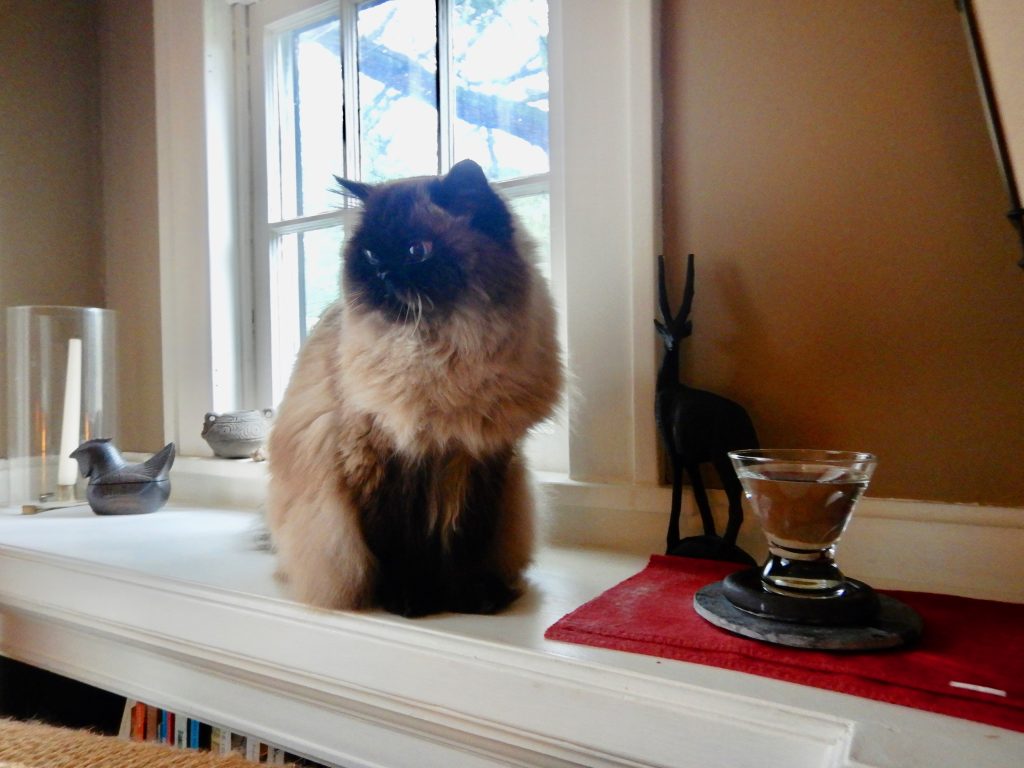 dry diets designed to manage urinary tract problems are often higher in carbs, contain added urinary acidifiers, as well as added salt to stimulate more drinking. We feel that an easier and more natural strategy could be to feed a grain free canned or raw diet, as meat is naturally acidifying, and the moisture is already integrated into the diet.
dry diets designed to manage urinary tract problems are often higher in carbs, contain added urinary acidifiers, as well as added salt to stimulate more drinking. We feel that an easier and more natural strategy could be to feed a grain free canned or raw diet, as meat is naturally acidifying, and the moisture is already integrated into the diet.
Provide fresh clean drinking water, but put it in other areas in the house that aren’t right next to their food. We can’t explain exactly why, but this seems to greatly increase the amount that cats drink. Some cats prefer a moving water source from a pet fountain. Use glass, ceramic or stainless bowls, never plastic. Filtered water is best (not distilled).
Pro Tip: Adding a little extra warm water to their canned or raw food can further help to hydrate them, increase palatability and satiation, and wake up its scent, especially when the food has come out of the fridge.
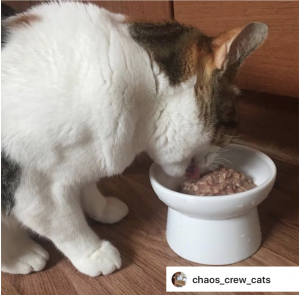 We believe that the best diets are commercially made raw foods for cats. Think of what the many millions of feral cats eat when they are not fed by humans: they default to their ancestral diet, one made of meat, bone, organs, and moisture, complete with enzymes, a wide range of amino acids, and without unnecessary carbohydrates and heat processing. There are many prepared raw foods on the market that provide balanced, safe and convenient ways to give whole food, species-appropriate nutrition as some or all of your cat’s diet. These include freeze dried raw diets that you reconstitute with water, and commercially prepared balanced raw food meals in the freezers. There are even lightly cooked meals in the freezers that would still be more nutritionally intact than canned foods. Over and over we see chronic health issues improved or resolved with a diet made from whole, minimally processed foods, so it stands to reason that these diets could have prevented these problems to begin with, extending lives and saving tons of money at the vet. These types of foods don’t have to be an all or nothing proposition. Some people feed raw food in the morning and kibble at night, or they sneak a tiny little bit of raw food mixed in with some of their canned food. Incorporating even one ounce of raw per day to their regular diet in this way could be considered a fantastic whole food supplement (a 3# bag contains 48 one ounce frozen nuggets and can cost something like $17.99 – that’s cheaper than any synthetic vitamin supplement on the market!). In fact, feeding raw food can be cheaper than feeding canned foods!
We believe that the best diets are commercially made raw foods for cats. Think of what the many millions of feral cats eat when they are not fed by humans: they default to their ancestral diet, one made of meat, bone, organs, and moisture, complete with enzymes, a wide range of amino acids, and without unnecessary carbohydrates and heat processing. There are many prepared raw foods on the market that provide balanced, safe and convenient ways to give whole food, species-appropriate nutrition as some or all of your cat’s diet. These include freeze dried raw diets that you reconstitute with water, and commercially prepared balanced raw food meals in the freezers. There are even lightly cooked meals in the freezers that would still be more nutritionally intact than canned foods. Over and over we see chronic health issues improved or resolved with a diet made from whole, minimally processed foods, so it stands to reason that these diets could have prevented these problems to begin with, extending lives and saving tons of money at the vet. These types of foods don’t have to be an all or nothing proposition. Some people feed raw food in the morning and kibble at night, or they sneak a tiny little bit of raw food mixed in with some of their canned food. Incorporating even one ounce of raw per day to their regular diet in this way could be considered a fantastic whole food supplement (a 3# bag contains 48 one ounce frozen nuggets and can cost something like $17.99 – that’s cheaper than any synthetic vitamin supplement on the market!). In fact, feeding raw food can be cheaper than feeding canned foods!
A Few General Tips for Feeding Kittens:
* Integrate some variety in the early days. Cats are what we call “imprint feeders”, meaning that they become very loyal (and sometimes painfully exclusive) to what they were fed as a kitten. If you only feed one type of food, it can be very difficult later if you want to change it. If a cat has only eaten dry food and you need to get medicines or supplements into them later, it’s difficult to mix them into food if they won’t eat wet food. If you feed cans, try using a good quality kibble as an occasional treat, or if you feed dry, reward them for a nail trim with a little canned food. Exposing them to real foods like small pieces of chicken is great for rewards for handling/nail trims/brushing, etc.
* Choose feeding times and stick with them. Cats become good at begging for food if they are rewarded by food when they beg for it! If they know when feeding time is and when it is not, they are less likely to bug you at other times.
*It’s worth noting that kittens eat quite a bit more than adult cats do for their size. Choose a food that says it is approved for all life stages of cat, and check the feeding guidelines for their weight and age, but feed less if your kitten’s getting pudgy or more if his hip bones are visible.
*Cats often seem to love fish, but ocean fish can be high in metals and contaminates such as flame retardant chemicals (PBDEs and PCBs). These compounds have been linked to feline hyperthyroidism. If their pickiness requires you to use fish, try for smaller-bodied fish species or use flavors that combine fish with other proteins. (**When purchasing carpets and furniture, try to make sure to avoid those containing fire retardants.)
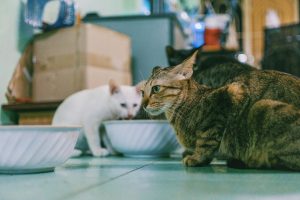 *Cats in multi-cat households should be fed separately. This gives you the ability to precisely control the amount of food each kitty is served, and lets you know immediately if their appetite drops off or picks up noticeably (both can be signs of illness). Dining alone also allows each cat to eat at his or her own pace without any need to compete or resource-guard. This will prevent the common problem of having one fat cat and one skinny one. From a human perspective, cats can be subtle about their communication with each other, and signs of intimidation between cats are easily missed. (This photo actually shows an annoyed tabby cat rather nicely – see those ears? and that kitten is seeing it too). Unlike dogs who are pack animals, cats have evolved as solitary hunters and having to share can cause stressful competition.
*Cats in multi-cat households should be fed separately. This gives you the ability to precisely control the amount of food each kitty is served, and lets you know immediately if their appetite drops off or picks up noticeably (both can be signs of illness). Dining alone also allows each cat to eat at his or her own pace without any need to compete or resource-guard. This will prevent the common problem of having one fat cat and one skinny one. From a human perspective, cats can be subtle about their communication with each other, and signs of intimidation between cats are easily missed. (This photo actually shows an annoyed tabby cat rather nicely – see those ears? and that kitten is seeing it too). Unlike dogs who are pack animals, cats have evolved as solitary hunters and having to share can cause stressful competition.
*Keep treats to less than 10% of their diet and make sure they’re made entirely or mostly of meat ingredients. Excellent ingredients include freeze dried meats and organs, rich in naturally occurring amino acids such as taurine.
*Many cats suffer from dental issues, which can result in expensive procedures requiring general anesthesia. If you start early in life, you may be able to desensitize cats to having their teeth brushed, or at least allowing you to inspect their gums in order to detect troubles. Go slowly and reward well. Feeding a starch-free diet can help dental health, and a fresh raw food diet contains enzymes that help to keep their teeth and gums healthy. Treats that can significantly help to maintain clean teeth are raw chicken necks fed whole or in smaller pieces (depending on age and experience). They contain small bones and connective tissues that are safe to feed, unlike cooked chicken bones. Never feed cooked poultry bones to dogs or cats! Cats have teeth and digestive tracts that are designed to eat small mammals and birds, and the cutting and crushing action scrubs and flosses their teeth (find them in our freezer). Raw chicken gizzards and raw hearts are also useful, and occasionally giving larger pieces of raw meat encourages them to use their back teeth to cut them into pieces. Another good dental treat is a whole, freeze-dried chicken heart. These light, crispy treats are large enough that they have to chew them into pieces, and are tidy to feed if you’re squeamish. We like to give one freeze dried heart every day. Hearts are also an excellent nutritional supplement, packed with taurine. (If your vet recommends the prescription diet TD, try hearts instead!)
Tips about kibble ingredients to avoid and strategies for feeding that can help you avoid health problems 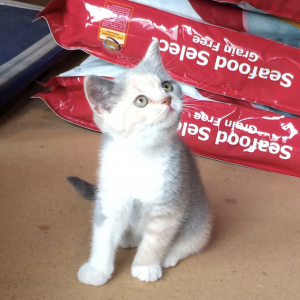 later:
later:
Though we’ve said here that we prefer wet foods to dry, we do realize that some cats might not be able to be convinced to switch. We also realize that kibble can sometimes be a more economical and convenient way to feed. Because of this, we’ve tried to stock the very best kibbles on the market, made with human grade ingredients and verified safe manufacturing processes. Some even have some freeze-dried raw ingredients applied after cooking, or are made without the use of synthetic vitamins and minerals.
Important things to look for when shopping for a kibble at any store:
*Avoid By-products and any meats or fats that don’t specify the species used. For example, you want it to say “Chicken Meal” or “Herring Oil” and not “Meat and Bone Meal” or “Animal Fat”. These are the ugliest ingredients in the pet food industry. According to the FDA, ingredients like “Meat and Bone Meal”, “Animal Fat” and “Animal Digest” are the most likely to contain euthanized animals and 4D meats (dead, dying, disabled or diseased) and the drugs that were used to euthanize animals can be detected as well when tests are done.
*Avoid artificial colors (ie: yellow #5) and chemical preservatives (ie: BHA, BHT, and ethoxyquin which are banned in other countries for their carcinogenic properties).
Avoid extremely grain-heavy foods, especially those with wheat, corn, and soy. Not only are these allergenic for some cats, they are simply a less expensive source of protein than higher quality meat proteins, necessary for cats to thrive. Grains like corn are very prone to dangerous, toxic grain molds like aflatoxin, and corn, soy, and beet pulp are likely to be GMO, so could have pesticide residues. Corn is a very high-glycemic food as well. High carb foods are the fastest way to put weight on your cat, and grains are high in phytic acid, which inhibits mineral absorption, possibly causing tooth and bone problems.
*Occasionally Rotate your foods. Don’t get in a rut where you feed the same brand and flavor for years and years. Think about it this way: no matter how much thought and care we might put into it, we couldn’t create a single plate of food for ourselves that would provide every nutrient we could possibly need, so that we could eat it for every meal of every day of our lives. It makes sense that doing this might eventually create a deficiency in something we need, or a nutritional excess in something that we’re eating that isn’t well suited to us. Each protein has a unique combination of amino acids, and each brand of food has chosen a different mix of fruits, veggies, fats, etc. Rotation allows for a greater variety and balance of nutrients over time. Rotation also allows you to observe changes in your cat’s appearance and vitality as you try a new protein or a new formula – every cat is different, and trying new things allows you to see what suits your individual cat. Some vets worry that people who change foods a lot won’t be able to identify what might be causing a problem for your cat if he has one, and for this reason we encourage you to make only one change at a time, blend between old food and new, and stay on a new formula for a few months to make sure it suits your cat before introducing another one. Always return something that isn’t working for your cat.
*If you think there is any chance that there is something wrong with a food you are feeding, always report it to the company and also to the store you bought it from. Always keep the packaging for a few days on any food, so that if you need to report it, the lot # will be available. This can help to protect other pets from safety problems as well as helping the store to notice patterns in returns that could indicate safety/manufacturing problems.
Pro Tip: There’s a brand of freeze dried raw food (Vital Essentials) that is hard and crunchy like kibbles. Switch from kibble to this food, or just mix some into their kibble diet to give them higher quality nutrients.
A Few Food Myths:
*Myth – Kibble cleans teeth – First, cats and dogs are carnivores; their teeth are not designed for chewing or grinding like ours are, they’re designed to shear through meat, bone and organs like scissors. The best they’ll do is crack a kibble and swallow it, which does not clean the teeth. Even for ourselves, no matter how crunchy something was that we could eat, it wouldn’t clean our teeth either, and the starches in kibbles can adhere to the teeth and become tartar. Raw food, on the other hand, contains enzymes that help to control bacteria in the mouth, doesn’t require starchy binders like kibble does, and doesn’t adhere to the teeth as much as kibbles and cans do.
*Myth – You should never feed your cat “human food”– True, some foods like pasta and Doritos would be inappropriate to feed your cat, but things like cooked chicken or other small pieces of meat are just better whole food versions of things that are already used in pet foods, and nothing magical happens to these ingredients when made into pet foods to make them more appropriate for cats. There of course could be behavioral problems that can occur if people are feeding these foods from the table or rewarding begging, but nutritionally speaking, whole foods make great training treats and food toppers. Note: when adding whole foods to a balanced diet, they shouldn’t make up more than 20% of the total amount fed without needing to discuss how to make them more balanced, and one should always consider portion sizes/calories when additions are made.
*Myth – Raw foods are more dangerous than kibbles – This is a misconception. Saying raw foods are dangerous implies that other forms of foods are inherently safe, and this is just not the case. The number of recalls for reasons such as Salmonella, Aflatoxin (a dangerous grain mold) and other problems like Melamine from China in kibbles, cans, and natural chews have killed and sickened thousands of pets and many people, though the CDC has no case on record of anyone confirmed to have been sickened by commercially prepared raw foods. The commercially prepared raw foods that we carry are made with the intention that they will be fed raw (unlike grocery store meats for humans which have allowable amounts of bacteria due to the fact that they are intended to be cooked) and are sourced, handled, and tested with care from farm to store to prevent problems. There are even some that are pasteurized using high pressure instead of heat. If your vet thinks raw foods are dangerous, please direct them to the Green Dog Blog’s article, “The Completely Healthy Food Your Vet Probably Vilifies“, written by Dr. Karen Becker , DVM. For a more detailed version of this Nutrition article see “Cat Nutrition” on the Green Dog Blog
Obesity:
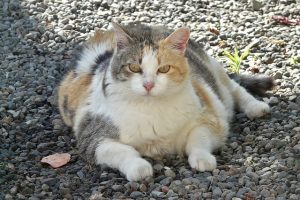 *Tragically, about 60 percent of pet cats in this country are overweight or obese (according to the Association for Pet Obesity Prevention) which puts them at much higher risk for chronic illnesses like diabetes and cancer.
*Tragically, about 60 percent of pet cats in this country are overweight or obese (according to the Association for Pet Obesity Prevention) which puts them at much higher risk for chronic illnesses like diabetes and cancer.
Viewed from above and from the side, a waistline should be visible. Feeling his ribs should be easy to do – if you have to dig for them to feel them, you kitty is getting too fat. Keeping a cat lean is an excellent thing to do to help avoid chronic illness and to keep his energy level high.
* A general guideline for adult cats is a 10# cat needs about 165 – 200 calories a day, and 15# cat needs about 220 – 300 calories per day. Feeding less should result in weight loss and feeding more should result in weight gain (though every cat is of course a little bit different, and the amount of exercise a cat gets will affect this). Kittens of course will eat up to twice the amount for their size. Here are some tips to help with weight control:
Feedings vs. free feeding: Leaving dry food down is convenient for humans, but free access to food can have some downsides. When you think about how cats evolved to eat, it helps us to understand how to feed them best. Grazing isn’t natural – cats hunt and kill food. When they’re starting to get hungry, they must find and catch it (which isn’t always successful), and then they rest between feedings.
Species appropriate diets help control weight. Studies have shown that simply switching cats from a kibble diet to canned food is very successful in creating weight loss. Cans tend to be higher meat and lower carb, and carbohydrates are largely responsible for creating weight gain in cats.
Feed cats separately in multi cat households especially if one cat is fat and the other thin. This reduces the stress of resource guarding and allows you to monitor the intake of each animal.
Exercise is vital to health and even can help prevent or treat behavioral issues. Play interactively every day with your cat to encourage running and chasing.
They should lose weight slowly. If you’re using portion control, cut back a little at a time to make it less noticeable. Never let a cat fast for more than 12 hours.
Hairballs and Vomiting Issues:
Many people come to think that vomiting is just a normal inconvenience all cat owners have to deal with, but frequent vomiting is a sign that something is out of balance in the body. This might be the result of a diet that contains ingredients that are not very digestible or are irritating to the cat’s digestive system (see info in the above “Diet” section about the most digestible, species appropriate foods for cats).
Many people assume that a vomiting cat must have hairball problems, which may or may not be true. Cats are designed to be able to tolerate a certain amount of hair in their diets (much of their natural prey is hairy) and they do groom themselves with their mouth. However, a cat who is shedding too much (perhaps from poor quality or moisture deficient foods, allergies, parasites, stress or other causes), who isn’t groomed frequently, or is undergoing a seasonal shedding period can have trouble with irritating amounts of hair. There are a few supplements that help with reducing shedding and helping to move hair through the digestive tract, which can be helpful in the short term. The most important thing would be to try to increase the amount of moisture in the diet to help hair move through, and increase the digestibility of the food that you’re feeding. Raw diets have been the most useful foods we’ve seen to help to heal certain chronic digestive problems over time, and raw-fed cats tend to shed a great deal less than cats on processed foods. (Changing foods can be less expensive than buying supplements to add to your current food.) Holistic vet, Dr. Karen Becker, says, “a digestive tract compromised by an inflammatory condition like inflammatory bowel disease (IBD), parasites, foreign objects, cancer, or another serious disorder may not be able to process even normal amounts of hair. A chronic hairball problem should be investigated by your veterinarian, since there could be an underlying disease requiring treatment. Remember: sometimes cats throw up, but chronic vomiting in a cat – even a long-haired one – is not normal. It’s important to identify the root cause of your kitty’s digestive dysfunction and work with your holistic vet to resolve it, and sooner rather than later. This will help prevent more serious GI issues down the road, like IBD, which in cats is linked to lymphoma”.
Toxins:
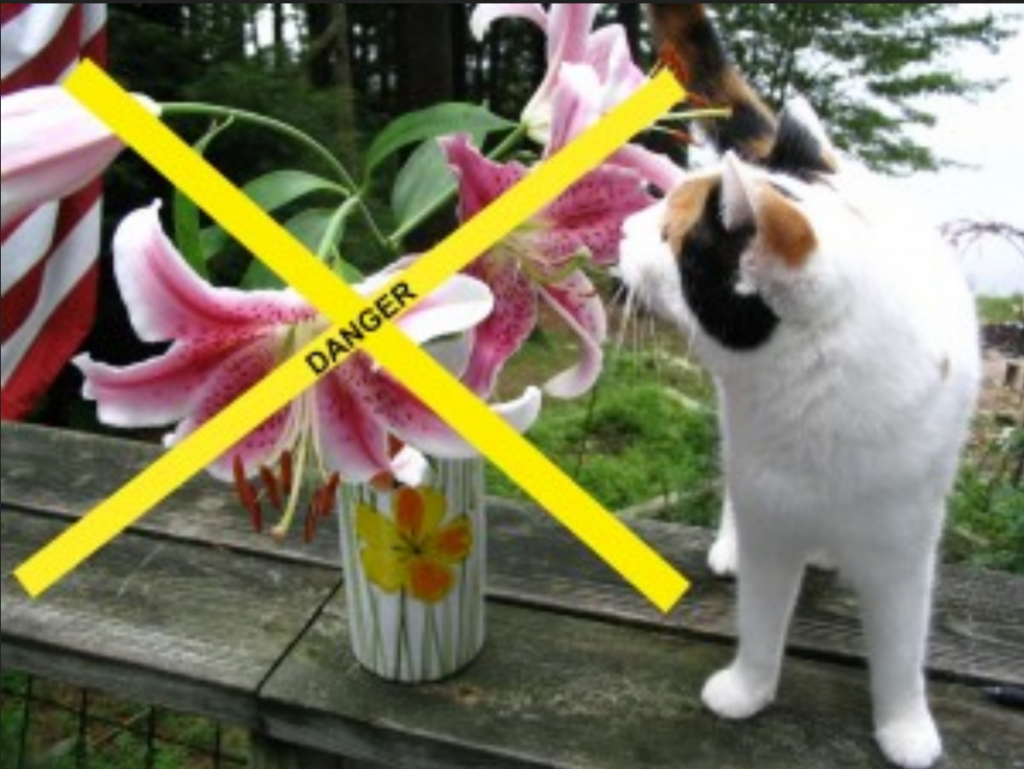 * Lilies: – Toxic lilies — including the Tiger, Asiatic, Stargazer, Casablanca, Rubrum, Day, Japanese Show and Easter lily — can prove deadly for your cat. Just a tiny amount of any portion of these plants, even biting the petals or drinking the water in the container that holds them can cause kidney failure. Other plants like Peace lilies, Philodendron and Pothos can cause oral and upper GI irritation, foaming at the mouth and inflammation when ingested.
* Lilies: – Toxic lilies — including the Tiger, Asiatic, Stargazer, Casablanca, Rubrum, Day, Japanese Show and Easter lily — can prove deadly for your cat. Just a tiny amount of any portion of these plants, even biting the petals or drinking the water in the container that holds them can cause kidney failure. Other plants like Peace lilies, Philodendron and Pothos can cause oral and upper GI irritation, foaming at the mouth and inflammation when ingested.
* Flea Products for dogs: Never use a canine flea/tick product on your cat. Depending on the ingredients in the product, just a drop has the potential to kill a cat within hours.
Essential oils: Cats can be extremely sensitive to many essential oils because they lack the ability to properly metabolize the various compounds in these oils. Some can be safer at very low dilution, but caution is warranted.
* Human medications: Antidepressants Cymbalta and Effexor topped Pet Poison Helpline’s toxic antidepressants list in 2013. For some reason kitties are drawn to these medications, which can cause severe neurologic and cardiac effects. Be cautious about not dropping pills that you’re taking, and keep medications secure when not in use.
NSAIDs: Cats are more sensitive than dogs to non-steroidal anti-inflammatory drugs like ibuprofen and naproxen. And because kitties are so sensitive, veterinary-specific NSAIDs should be used with extreme caution, if at all. Acetaminophen (a common painkiller in cold and flu meds) is especially toxic to cats – it damages red blood cells and causes liver failure. If your kitty is in pain consider CBDs, which are safe and effective for pain and discomfort, or of course talk to your vet for other options.
Behavior
Cat communication:
* Cats that are happy to see you might rub their face or bonk their heads on your 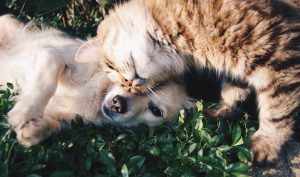 hands or legs, etc. This not only feels good to him, he’s rubbing his scent on you and telling you you’re nice enough to be in his club (this is called “bunting”). He might also roll on the ground and expose his belly. He’s telling you he’s happy and trusts you enough to show you his most vulnerable areas. It is NOT generally an invitation to touch said areas, especially if you don’t know this cat well. The nicest and most intimate gesture would be the slow blink: When a cat offers a slow, languid blink, it’s something they would only do for someone they care about and trust. You can return this gesture, and even use it to calm a nervous cat. See how to do it here
hands or legs, etc. This not only feels good to him, he’s rubbing his scent on you and telling you you’re nice enough to be in his club (this is called “bunting”). He might also roll on the ground and expose his belly. He’s telling you he’s happy and trusts you enough to show you his most vulnerable areas. It is NOT generally an invitation to touch said areas, especially if you don’t know this cat well. The nicest and most intimate gesture would be the slow blink: When a cat offers a slow, languid blink, it’s something they would only do for someone they care about and trust. You can return this gesture, and even use it to calm a nervous cat. See how to do it here
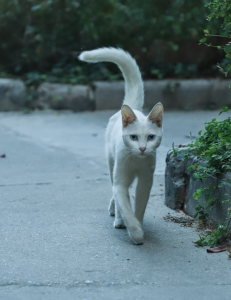 * A cat’s tail is the barometer of how he feels. When truly relaxed, a cats tail is relaxed as well. If he’s feeling uncomfortable, it will start to twitch. If you’re petting them too long or too roughly, it will start to really whip around. Consider it a warning that the cat might not be able to take much more. Inquisitive and relaxed cats will approach with ears forward and their tail up high, often in the shape of a question mark.
* A cat’s tail is the barometer of how he feels. When truly relaxed, a cats tail is relaxed as well. If he’s feeling uncomfortable, it will start to twitch. If you’re petting them too long or too roughly, it will start to really whip around. Consider it a warning that the cat might not be able to take much more. Inquisitive and relaxed cats will approach with ears forward and their tail up high, often in the shape of a question mark.
* A nervous cat might have his tail down low or tucked between his legs, his ears back, 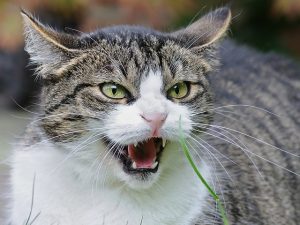 his pupils might be very round and dilated, and he might slink through the room, staying low and looking for somewhere to hide. He might turn his head away, avoiding interaction. A frightened defensive cat might crouch low with his tail wrapped around him, have dilated pupils and flattened ears. he might growl or hiss.
his pupils might be very round and dilated, and he might slink through the room, staying low and looking for somewhere to hide. He might turn his head away, avoiding interaction. A frightened defensive cat might crouch low with his tail wrapped around him, have dilated pupils and flattened ears. he might growl or hiss.
* When a cat is startled or encounters something frightening, they might look like that typical Halloween cat. Their fur (especially on their tail) will stand on end, Their back arched, ears back and flat against the head, whiskers back, hissing, yowling or growling. Remember, if a cat’s ears are back and flat against the head, this is a serious situation. They’re telling you they are very frightened and will attack if pushed further.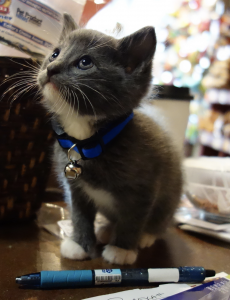
* Don’t forget that in the wild cats are both predators and prey. Their smaller size means they’ve had to evolve to be cautious about their own safety. This explains why cats are easily startled, defensive, can be fearful of changes, and tend conceal symptoms of illness. Their default response to frightening things may be to hide, and are also very likely to hide if they are sick or in pain. Help your kitten become secure with novel objects, get them used to things like riding in the car, entering a crate to get treats, and meeting lots of nice people. Maybe bring them on field trips to our store!
Introducing a New Cat To The Home (or even introducing your cat to a new house when you move):
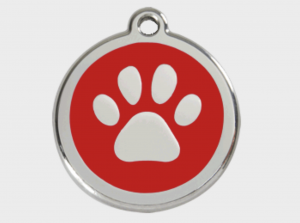 *Make sure to get i.d. tags as soon as you can to avoid losing a new pet in an unfamiliar environment. Don’t forget to update your information if your cat is micro-chipped.
*Make sure to get i.d. tags as soon as you can to avoid losing a new pet in an unfamiliar environment. Don’t forget to update your information if your cat is micro-chipped.
*Don’t forget to pet-proof your house. Move cords and plants out of reach, and make sure the floor is free of small things that can be swallowed, like rubber bands, ribbons, etc.
*If your own cat is moving with you to a new home, perhaps bringing a familiar unlaundered comforter or an item of your own clothing to help them feel reassured. Even better, set up your mattress with its regular bedding first and close the cat in that room before you start bringing boxes and other furniture into the home. Put a doorstop or sign on the door to prevent movers from accidentally opening that door.
If you allow them to roam in the new home too soon, they might hide somewhere that is difficult to find them, or attempt to escape through an open door. Allow the cat to explore the rest of the house when they seem more comfortable and relaxed and you can supervise.
Make an effort to play with them daily to produce “happy” endorphins and burn off stress in the new environment.
*When bringing a new cat to an existing home: If possible, bring the new cat into one smaller comfortable room and allow them to become familiar with this new place before expanding their exposure to the rest of the house or to other animals. Provide a litter box in one area and food and water bowls in other areas of the same room and a comfortable sleeping area. Feliway plug-ins or sprays mimic “happy” pheromones that cats produce naturally and can be useful to many cats to help them feel more relaxed in a new environment.
*If there are other animals in the home, occasionally allow the new cat to explore the rest of the house without the other animals present. This will allow the new cat to become familiar with the layout and learn where escape routes are that they might use if the resident animal(s) chase them when they are introduced.
*When introducing the cat to a resident dog, baby gates can be useful to provide the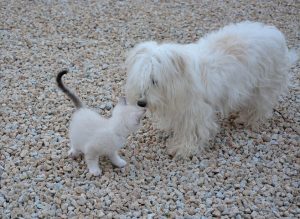 cat with escape routes when the dog is big and the cat can easily jump over an obstacle. If the cat is a senior, perhaps leave space under the gate for them to squiggle under. Keep your dog on a leash at first or at least dragging a leash to allow you to prevent chasing. Reward the dog frequently for calm behavior when the kitty is in the room. Chasing a running animal is extremely rewarding to a dog, so turn it around for the dog and instead make the most rewarding thing be staying calm and quiet when the cat is near. When they try to chase the cat, they lose access and are moved into another room or outside. Don’t let them practice chasing the cat or it may become a pattern hard to break.
cat with escape routes when the dog is big and the cat can easily jump over an obstacle. If the cat is a senior, perhaps leave space under the gate for them to squiggle under. Keep your dog on a leash at first or at least dragging a leash to allow you to prevent chasing. Reward the dog frequently for calm behavior when the kitty is in the room. Chasing a running animal is extremely rewarding to a dog, so turn it around for the dog and instead make the most rewarding thing be staying calm and quiet when the cat is near. When they try to chase the cat, they lose access and are moved into another room or outside. Don’t let them practice chasing the cat or it may become a pattern hard to break.
To introduce cats to each other, here are some tips:
*Transferring that group smell to the new cat may make the household cats a little more likely to accept it. If there are other cats in the household, rub their bodies and especially their faces with a cloth, then rub the new cat down with the cloth. If the resident cat(s) love to rub their cheeks/lips on a brush, then brush the new cat with this smell. Make especially sure to do this right before an introduction.
*It’s a great idea to feed the cats in the household on opposite sides of a solid door at the same time twice a day. After they’re done eating, a play session and/or treats for each cat after meals will go a long way. They will be able to hear and smell one another, and having positive things happen in proximity to the other kitty will create positive associations with each other. Playtime also helps to create the happy hormones that will help to dissipate stress and associate proximity with positive things.
Once they’re doing well with this routine, switch places for the cats with the new one in the home and the resident cat in the bedroom. Flip flopping them may help prevent them from becoming more territorial about areas in the residence, and will give the resident kitty a chance to really check out the smell of the new cat.
*A few clever customers have put an old screen door up where the solid door was, to allow them to see and smell each other without being able to cause injury. One resourceful customer used tension rods to keep the screen door wedged into the doorjamb instead of attaching it to the wood or hinges. They can continue to eat in close proximity and have playtime afterwards, but now they can see each other.
If you can’t find a screen door, crack the solid door open one inch and secure it so it can’t open further. A rubber doorstop might be handy for this.
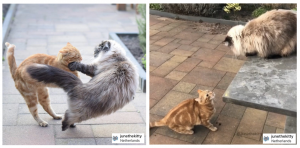 *Think about your rooms and see if you can provide more ways to increase the vertical space in common areas (so cats can get up high). Moving a piece of furniture might create a bridge that allows cats to use a shelf or mantle. Making shelves is easy by putting up some inexpensive L-brackets and a piece of wood (you can even paint them to match the room). This can create great escape routes and resting spots for cats (make sure there’s not a dead end). When cats have to share the same territory, it’s nice to increase their options for being out of each other’s way. This is especially important if a new puppy has just joined the household.
*Think about your rooms and see if you can provide more ways to increase the vertical space in common areas (so cats can get up high). Moving a piece of furniture might create a bridge that allows cats to use a shelf or mantle. Making shelves is easy by putting up some inexpensive L-brackets and a piece of wood (you can even paint them to match the room). This can create great escape routes and resting spots for cats (make sure there’s not a dead end). When cats have to share the same territory, it’s nice to increase their options for being out of each other’s way. This is especially important if a new puppy has just joined the household.
*The next step is to give them short periods of supervised interaction (they could both wear harnesses if you wanted to play it really safe), but separate them when they cannot be supervised. Remember – sometimes it takes quite a bit of time for cats to come to terms with each other. Be patient.
Please Consider keeping your cat Indoors
Between 2-4 billion birds and 7-20 billion small mammals are killed by cats every year in the U.S. alone. The introduction of cats has caused the extinction of at least 33 endemic species on islands throughout the world. We of course adore our cats here in the U.S. and want them to be happy. We (Christine and Mike) personally deeply respect their natural behaviors, and we try to meet our Otis’ needs for prey/predator simulation via interactive play every day. When we first adopted him at 10 years old, we were dedicated to turning him from an outdoor cat to an indoor cat – he had already been hit by a car in his lifetime, disappearing for a few days before showing up on the lawn and needing $5,000 in emergency surgery. He’s a fancy looking Himalayan with a laid back social nature, so he was stolen twice from his previous owner, and luckily recovered (one time by a friendly uniformed officer that was willing to mediate). Otis was a neighbor of Green Dog and he regularly 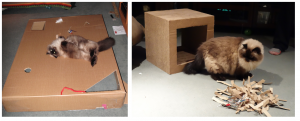 wandered in and spent time with us in the store, but never did learn how to be careful in traffic and had several close calls, so we asked to adopt him. We committed ourselves to daily environmental enrichment for him (regular introduction of piles of paper to play in, boxes with holes of different sizes, bags, etc rotated through his play area). Being food motivated, he also enjoyed learning tricks for treats (he learned about 16 of them over time). The most important part of the puzzle was daily interactive play. Using toys to simulate the movement of prey animals that he could chase and hunt was key to keeping him satisfied as an indoor cat. The best interactive toy remains the “Da Bird” toy with its various attachments (sparkle, mouse and of course the spinning flying feathers). For really energetic catches, we’d give him a treat. For his very best most spectacular catch of the evening, we ran upstairs and gave him a 3/4″ piece of meaty raw chicken neck, full of tiny crunchy bones and cartilage. (Never give your cat cooked chicken bones!) which allowed him to “hunt”, “catch” and “eat a bird” in a fairly awesome simulated way. It was truly satisfying to him. It also supercharged our play sessions, making him ultra-motivated to play every night and to run harder and faster. He knew that there was something in it for him! What we haven’t done for him yet but we aspire to is to build him some sort of catio.
wandered in and spent time with us in the store, but never did learn how to be careful in traffic and had several close calls, so we asked to adopt him. We committed ourselves to daily environmental enrichment for him (regular introduction of piles of paper to play in, boxes with holes of different sizes, bags, etc rotated through his play area). Being food motivated, he also enjoyed learning tricks for treats (he learned about 16 of them over time). The most important part of the puzzle was daily interactive play. Using toys to simulate the movement of prey animals that he could chase and hunt was key to keeping him satisfied as an indoor cat. The best interactive toy remains the “Da Bird” toy with its various attachments (sparkle, mouse and of course the spinning flying feathers). For really energetic catches, we’d give him a treat. For his very best most spectacular catch of the evening, we ran upstairs and gave him a 3/4″ piece of meaty raw chicken neck, full of tiny crunchy bones and cartilage. (Never give your cat cooked chicken bones!) which allowed him to “hunt”, “catch” and “eat a bird” in a fairly awesome simulated way. It was truly satisfying to him. It also supercharged our play sessions, making him ultra-motivated to play every night and to run harder and faster. He knew that there was something in it for him! What we haven’t done for him yet but we aspire to is to build him some sort of catio.
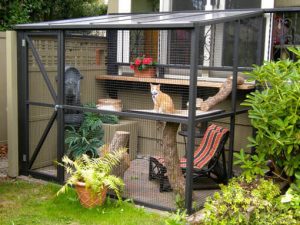 What’s a catio? It’s an enclosed outdoor space for kitties that keeps them safe from harm’s way and protects much of the wildlife that is harmed by outdoor cats every year. It can be the simple modification of an existing porch by adding screening or mesh, it can be a structure built off of a window, or a tunnel system that they can travel through above the ground. It gives them the sights, sounds and smells of the outdoors, minus the risk. Even a small enclosure attached to a window can bring an indoor cat a lot of pleasure.
Can you imagine letting your dog out the door and into the city in the morning and saying, “Have a good day! See you tonight! Hope you don’t get into trouble out
What’s a catio? It’s an enclosed outdoor space for kitties that keeps them safe from harm’s way and protects much of the wildlife that is harmed by outdoor cats every year. It can be the simple modification of an existing porch by adding screening or mesh, it can be a structure built off of a window, or a tunnel system that they can travel through above the ground. It gives them the sights, sounds and smells of the outdoors, minus the risk. Even a small enclosure attached to a window can bring an indoor cat a lot of pleasure.
Can you imagine letting your dog out the door and into the city in the morning and saying, “Have a good day! See you tonight! Hope you don’t get into trouble out 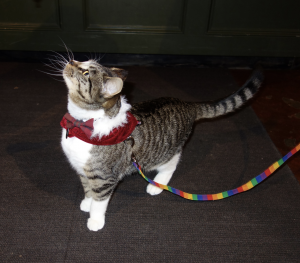 there!”? I can’t tell you how many stories we hear regularly in the store about people losing their cats to coyotes, cars, infections due to fights, etc. Check out different catio designs online – you might be inspired! Resources here
there!”? I can’t tell you how many stories we hear regularly in the store about people losing their cats to coyotes, cars, infections due to fights, etc. Check out different catio designs online – you might be inspired! Resources here
You can also habituate your cat to wearing a harness for supervised visits outdoors. Look up “Adventure Cats” on Google or Instagram for inspiration, and ask us how to set them up for adventure cat success!
Behavioral Problems:
“My Cat Scratches the Furniture”:
Cats are designed with a need to scratch, and scratching is important to them for many reasons. First of course, it is a way to keep those claws in good condition – it helps them to shed the outer layers of their nails and to keep the tips sharp and strong. Claws and teeth are the primary tools used to catch and consume prey, as well as helping them defend their territory from interlopers. The shredded material on their preferred scratching areas creates a visual “signpost” that shows other cats that they own and maintain their territory. They have scent marking glands between their toes that emit a pheromone that backs up this message as they scratch, and they like to keep that pheromone smell fresh (you can’t smell it, but they certainly can – even declawed cats will enjoy going through the motion of scratching certain spots to apply that scent – pay attention to any cat having a good scratch and you may see them lean in for deep satisfying whiffs of that pleasing smell).
Scratching also appears to feel good and helps them to stretch out their muscles and joints. This behavior can be quite destructive in the household if cats don’t feel like the scratching options you’ve provided are as desirable as other places in the house (like furniture). When you bring a new cat home, they may not start scratching right away until they feel like the new space is becoming their own. When they do, notice where they’ve chosen – is it horizontal (like on a carpet) or vertical (like on the front of the couch)? You’ll want to use this information and find a scratcher that is as good or better in the cat’s eyes than that spot, but hurry – you don’t want them to become attached. If they’re a horizontal scratcher, flat cardboard scratchers are inexpensive and useful – get the largest size you can find so they can stand on it and scratch. There are also good sisal horizontal scratchers with rubber feet, or perhaps a piece of indoor outdoor carpet made of coir or other natural material, or even a woven welcome mat can solve your problem. Some horizontal scratching cats enjoy a small vertical post which has been tipped on its side, which then looks sort of like a log that’s propped at an angle. Put it right over the spot they’ve chosen – when they grow to love it you can move it slowly towards a more convenient spot if necessary. If they’re a vertical scratcher, make sure you buy a vertical post that is tall enough for them to really stretch up high. Some posts are even designed to fit right up against furniture (with the post attached to the back of the base instead of at the center) – these are very handy to block a spot on furniture they’ve chosen. Try to mimic the feeling of what they’re scratching – a cat that scratches a wicker laundry basket might like a sisal rope scratcher, and those that choose soft couches might like a carpeted post. Some posts have both. The “Kitty Block” is among the very best scratchers in the industry, as they are sturdy blocks of corrugated cardboard that can be stacked, providing either vertical or horizontal scratching surfaces as well as sleeping spots, and they can be stacked and rearranged.
If they start scratching an unauthorized spot, never chase them off of it or use squirt bottles. They will perceive that as you saying “no scratching allowed” and will simply label you as “crazy person” and wait until you’re not around to scratch that spot, as they need to scratch! Instead, you want to say “don’t scratch here, scratch there instead” by calmly walking over to them, picking them up (if they tolerate it) and moving them to their approved scratcher (putting a scratcher right near that spot is clever, and you can slowly move it farther away when they’re using it regularly). Some cats can be encouraged to scratch it by making scratchy noises on it with your fingernails. A little catnip on the scratcher can help some cats. Keep treats near that scratcher and reward the behavior if they do it in the right spot. Cover that damaged furniture with a blanket when you’re not around so they don’t practice the behavior, and uncover it when you’re home so you can interrupt and redirect them to the new one.
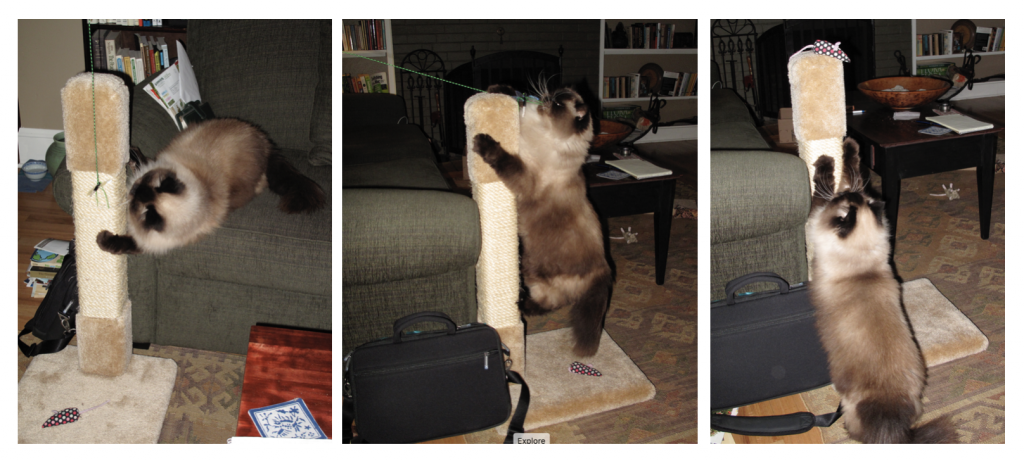
When you buy a new scratcher, always play with them near it, dragging a toy or a string that they’ll chase with their feet as it trails over the new scratcher’s surface. As they dig into the surface trying to catch the toy, they will be feeling the scratching potential and leaving that pheromone smell on the scratcher, and will want to freshen that smell with scratching. Lastly, it helps them to feel like this new thing is a happy place for kitties, making it “theirs”.
Feliway spray is a great product that mimics a different pheromone that lessens territorial stress and can be a great tool for discouraging them to scratch an unauthorized spot or to apply right onto a new couch on its first day in the house to lessen their desire to use it for scratching. Nothing is 100% useful for every cat, but the percentage of cats that this helps is very high.
Provide multiple scratching spots in multi cat homes.
Doing the work that it takes to find the right scratching pad or post and to make them fall in love with it can lead to a lifetime of good scratching behavior and a less stressful relationship.
We are strongly against declawing. Check out this link
“My Cat Attacks Me”:
If your cat hides under the bed, jumping out and biting your legs when you 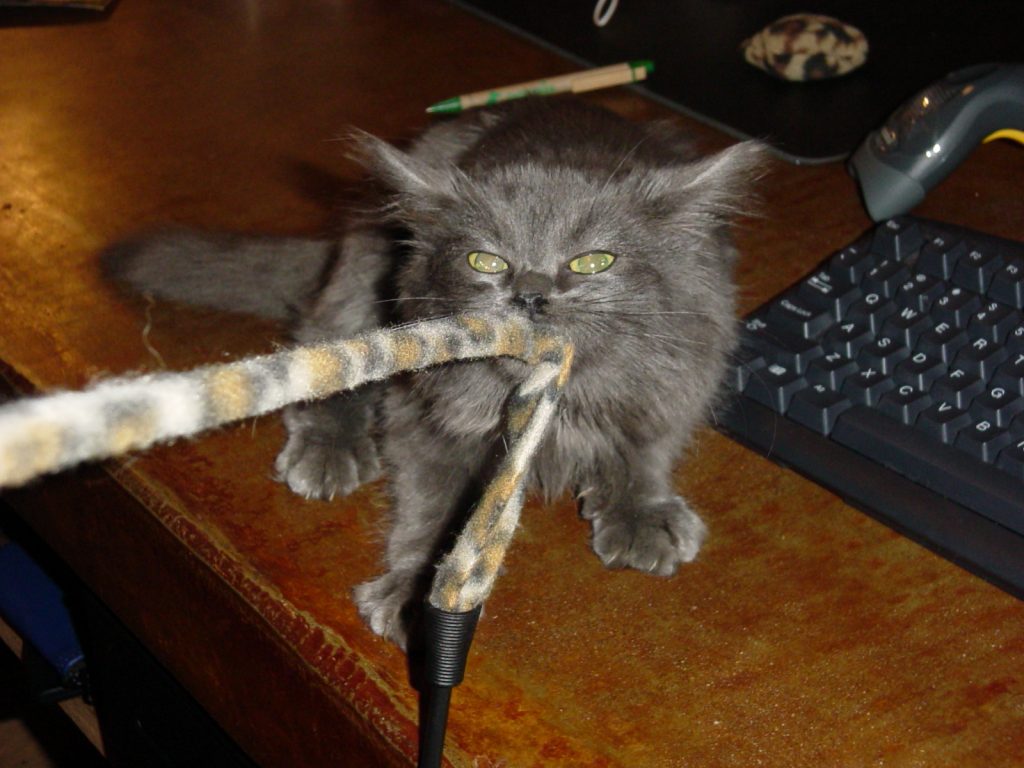 walk by, they almost certainly could use more exercise in the form of interactive play. This is especially common in kittens and young cats, but just like dogs, all cats need activity, stimulation, and quality time with their people to stay happy and mentally balanced. Giving a novel toy for them to play with is good, but it quickly becomes boring. It’s very important that cats receive some sort of interactive play each day, especially indoor cats. It’s as important as walking your dog. They need that outlet of simulated hunting every day. Using a wand toy is a useful way to encourage this physical activity, which can have positive effects in all areas of a cat’s life. Be creative about finding simple things to bring home that they can investigate and use your wand toy to play in these materials and make the game more interesting (crumpled packing paper, boxes with little and big holes cut in it, grocery bags, etc). Recycle them when they become boring and find something new.
walk by, they almost certainly could use more exercise in the form of interactive play. This is especially common in kittens and young cats, but just like dogs, all cats need activity, stimulation, and quality time with their people to stay happy and mentally balanced. Giving a novel toy for them to play with is good, but it quickly becomes boring. It’s very important that cats receive some sort of interactive play each day, especially indoor cats. It’s as important as walking your dog. They need that outlet of simulated hunting every day. Using a wand toy is a useful way to encourage this physical activity, which can have positive effects in all areas of a cat’s life. Be creative about finding simple things to bring home that they can investigate and use your wand toy to play in these materials and make the game more interesting (crumpled packing paper, boxes with little and big holes cut in it, grocery bags, etc). Recycle them when they become boring and find something new.
Teach them tricks – cats are smart and can easily learn simple behaviors like sit and turn around in a circle, etc. especially if you can find small treats they really like as rewards. Otis learned 16 tricks in the first year or so that we had him, and he was 10 years old.
Remember that if they are acting like jerks, cats may just be terribly bored and badly need more stimulation in their lives. Just like us, when an animal exercises it provides good mental stimulation as well as having physical benefits. Getting the heart rate up stimulates endorphins that reduce stress and create feelings of calmness. Interactive play can improve almost any behavioral problems, (including reducing tension between cats in the household) and can improve your relationship with your cat.
“My cat seems to want me to pet him, but then suddenly bites me”:
This is a common problem, but it can be resolved with a greater awareness of how you touch the cat and how well you recognize cat body language. First, be soft and gentle with your cat and avoid rough scrubbing and pat-patting. They are easily overstimulated and overwhelmed by a lot of rough touching, and they might have boundaries about where they feel comfortable being touched by people they’re unfamiliar with (these boundaries can be changed over time as you develop more of a trusting relationship). Also, cats often reflect your behavior, and if the cat thinks you are behaving roughly with them, they will give that back to you. Watch for these signs: When resting and content, a cat’s tail is soft and relaxed, and their ears are facing forward. If they start to become annoyed, their tail will start to twitch, and then start to slap down. As annoyance increases, the tail will be more active. If a cat’s ears are turned sideways like an airplane or back beware – the cat is saying they can’t take much more. He might even growl or put his teeth on you to tell you to cease and desist, and if you continue, he might bite and scratch. Heeding the earlier warning signs will keep him more comfortable with proximity and build his trust.
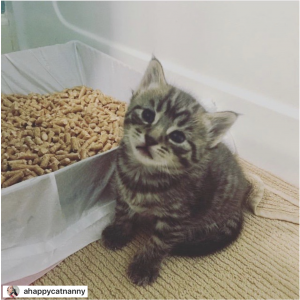 Setting Your Cat Up For Litter Box Success:
Setting Your Cat Up For Litter Box Success:
* Both wild and feral domestic cats prefer to eliminate in different areas outdoors every time, covering the scent of their waste in the soil. Luckily, indoor cats are pretty amenable to using a litter box as long as conditions seem acceptable to them. Just know that if they ever start to eliminate outside the box, they’re telling you that something is wrong. Though it may seem to humans that this behavior conveys “spite” this is not the case. Realize that what you’ve asked them to do is against their true nature, so be patient and aware that they need your help to modify the situation.
* The general rule is to have one box for every cat in the house, plus one. Don’t force cats to use the same box, and perhaps put some space between them if possible. A bigger box with higher sides keeps mess contained. Hoods can make things even tidier for a big digger, but not all cats feel safe losing that visibility. If you want to use a hood, get them used to a new box without the hood first, and then pay attention to their reaction. Sometimes a really deep open topped Rubbermaid storage container is the solution for cats that kick their litter everywhere. Put all boxes in quiet, low traffic areas if possible.
* Find a litter you both like. Most cats prefer a softer texture such as a scoopable clumping litter. The downside is that all scoopable litters track. Use a good litter mat or a fluffy bath mat to capture the mess. The upside is that when you find a litter that clumps quickly and firmly, removing those clumps leaves very clean litter behind keeping your box nearly odor free. If your clumping litter breaks apart as you shake your scoop, get a new litter and your box will smell fresher. Litter that comes in pellets reduces tracking significantly, but not all cats like the texture. Starting kittens on pellets will likely increase your success. The downside of pellets is that they don’t clump, and urine dissolves them into wet sawdust that is harder to remove entirely. Keep the level of litter shallower than a scoopable litter (just a few inches vs. 3-4” of scoopable) so not as much litter is ruined at a time. Perhaps use a solid spoon or spatula to lift urine spots. We recommend unscented plant based litters (made from grass, corn, wheat, etc) over clay. These litters are more sustainable than clay; as all clay is strip-mined, it uses more fossil fuels to ship as it’s heavier, and it doesn’t degrade. Plant based litters are lighter to carry and to scoop, they generally clump quickly (wasting less litter), they handle odor well, many brands aren’t as dusty as clay (and clay dust is dangerous to breathe), and the bags last longer than clay, saving you money.
* Keep your boxes clean. Scoop once a day. Having that extra box mentioned above allows them to find a clean spot if you’ve forgotten to scoop. Cats prefer as little odor from their boxes as possible (as do you). Empty and clean your box regularly. You can spray with an enzymatic cleaner and wipe clean and dry and refill with clean litter, or take it outside and hose and scrub.
Pro Tip: Cats fed dry food generally have more concentrated and smelly urine. Switching to a moisture rich diet helps the urine smell and their health. Even better, a raw-fed cat’s box generally doesn’t smell! Their poops are smaller and harder and not as stinky, and their urine doesn’t really smell either. If you walk into your house and you can smell your well maintained boxes, look to their diets to solve the problem.
* When switching litters, a sudden switch might be upsetting. Use your extra box to introduce a new litter, and if they jump right in and use it, you’re done! If they never use it, try adding a layer of their old litter to the top of the new litter, or put a urine clump from their old box into the new litter. If you happen to only have one box, try to replace clumps you’ve removed during cleaning with the same amount of fresh litter. Eventually your box will be mostly new litter, and the next time you empty your box you can fill it entirely with the new litter. If they boycott their box during the process of switching, go back to the old litter and try a different one in the future.
Inappropriate Elimination And Marking:
If your cat suddenly stops using their box, the very first thing to do is bring them to the vet to eliminate medical causes such as urinary infections or crystals. When in pain, cats often hide their symptoms. They often associate pain with the litter box and try to find a place where it might not hurt as much. Other symptoms can be howling in the box, excessive licking of the genital area, blood in the urine, and frequent attempts to urinate.
* If your cat ever visits the box repeatedly, strains to urinate but voids little to no urine, it’s vitally important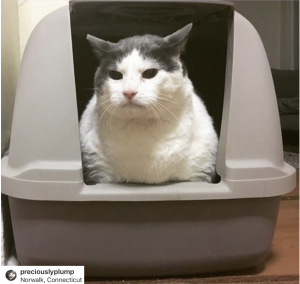 to rush them to the vet or to emergency care if it’s after hours. Urinary blockages can be a life threatening emergency, especially in male cats.
to rush them to the vet or to emergency care if it’s after hours. Urinary blockages can be a life threatening emergency, especially in male cats.
* Once medical reasons have been eliminated, one must consider sources of stress. These may include: A new member of the household, person or animal. A new outdoor cat in the neighborhood, marking under open windows, in a crawl space under the house, on the outside of an entry door, etc. Another cat in the household intimidating them in ways you may or may not have noticed. Humans having frequent disagreements. Living with an adult that doesn’t like them. Children chasing or harassing them. Lack of environmental enrichment/stimulation/exercise. The cat finds something about his litter or box that is stressful, such as a change in litter (especially one with a strong scent, relocation of box, change in the room the box is in, etc. These reasons would be qualified as “marking”, which is not an elimination behavior, but could be a sign of territorial stress. Marking often takes the shape of “spraying”. Cats (male or female) who are spraying might lift their tail straight into the air and quiver it as they spurt urine onto a vertical surface. Cats can also squat to mark objects on the ground. Inappropriate elimination is generally emptying their bladder in the wrong place. These two things are often easy to confuse. A cat intimidated by another cat might be inappropriately urinating due to stress, even though he doesn’t have a medical problem. But please note: this cat might then develop a medical problem like cystitis or trouble with crystals if he is not allowed access to his box.
As Dr. Karen Becker, DVM says, “Under no circumstances should you ever punish a cat for improper elimination. Imagine if you were forced to relieve yourself in a dirty, cramped or unnatural spot, with activity swirling around you. Then imagine being punished for finding a more suitable location for yourself. The reason for their behavior may not make sense to you, but it does to your cat, and now is a good time to remember he is, after all, a different species! Your pet needs your help to find the cause of his behavior and fix the problem.Work with your cat, not against him, to help him be comfortable with his potty area”.
Here are some ideas for managing your cat’s environment and lowering his stress to help to resolve the problem:
* Of course reevaluate your box situation and all of its variables.
* If it might be a new person or someone that the cat is uncomfortable around, try to enlist their help and sympathy (as they’d probably like the marking to stop too!) Have them try to stay calm and speak softly near the cat. Have that person gently toss a treat the cat likes in front of him and retreat without approaching too directly. Have them put the food bowl down at mealtimes. They might be willing to play a little with a wand toy or string, etc. No rough or overstimulating touching, like roughing up the fur – let the cat approach them and they don’t approach the cat.
* Other cats: Try Feliway Multicat diffusers in the home. Increase the number of scratching areas available. Can the space be managed to give them their own areas for a while? Look at your common areas and see if you can increase the amount of vertical space for the cat. What if you could put a high-backed chair in between the couch and the mantel to make it accessible to a cat? Cat trees are useful of course, but inexpensive shelves made with scraps of wood and L-brackets can be used to create high spaces for cats to retreat and feel secure (especially useful when there are children or new puppies in the home). If there is another cat, make sure there are no dead ends to the escape routes. Perhaps there’s a way to subdivide the home to create separate territories? You might have to ask yourself if the cats would be happier in separate homes.
* Puppies/other dogs: Don’t allow puppies or children to chase the cat. Puppies can drag a leash when supervised, and reward the puppy (and praise children) for calmness when a cat is in the room. Until they’re friends, allow your cat time in the house when dogs aren’t present, or give them access to a room that the dog can’t get into, using a baby gate.
* If the problem is an outdoor cat, try to block access (to a crawlspace etc). Use Feliway spray on the outside and inside of the doors. Make outdoor areas the cat is spending time in less comfortable – perhaps put down pointy rocks under windows, or those plastic carpet protectors with plastic spikes on the bottom – flip it over and it’s an uncomfortable surface to walk on. There are even motion activated sprinklers available (search “Scarecrow sprinkler”)
*CBDs are very safe and effective for calming anxiety. We carry a tincture that is completely tasteless for mixing into food, and a few that are in treat form.
*Interactive playtime and enrichment is very important every day for all cats, but especially for a stressed cat.
Other Cat Tips:
* Handle your kitten gently but frequently in ways that will help them become accustomed to grooming and care. When they’re sleepy, massage their feet and handle their toes. Get them used to you pressing gently to extend their toenails. Occasionally clip the tip of one toenail and then give a great treat or start a fun game. Brush them gently with a soft brush for a short time and reward them. Open their mouth and look at their teeth. Work up to rubbing their gums with your finger. Anything you can do to get them to allow you to clean or inspect their teeth when they get older will really save you $$ and hardship, as cats are so prone to dental disease.
*Don’t play or roughhouse with a new kitten using your bare hands or feet – you don’t want to teach them that this is how you want them to interact with people.
* The more you talk to your cats, the more vocal they will become. They can develop many unique sounds to communicate with you which can be very fun, or can become very annoying. Remember that just like dogs that whine or bark to get your attention, rewarding vocalizations you don’t like with attention will increase this behavior. Quiet kitties get treats and meals! Loud demanding kitties should get ignored. Remember that an increase in vocalizations can also be a cry for help if the cat is in pain, feeling anxious, or experiencing age related changes. Senior and geriatric cats do tend to vocalize more, especially at night. See your vet to rule out illness.
*Fun Fact: Cats have scent glands at the corners of their mouth, under their chins, at their temples, on their ears, and along their tails, (as well as between their toes). This is why they often are more tolerant of being stroked from the head along their back and up their tail than on other areas of their body, and why they might rub on you with these areas. The more they love you, the more they’ll want to mark you with their scent. Be flattered!
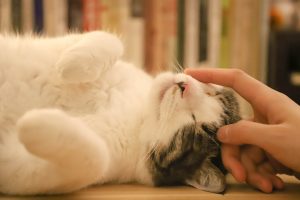 Talk to us – we’re here to help brainstorm. We have some real cat experts on our team! We know that very deep and special connections can be developed between cats and their owners. It can be a real pleasure to develop a relationship with a species whose behavior has remained essentially the same as its wild
Talk to us – we’re here to help brainstorm. We have some real cat experts on our team! We know that very deep and special connections can be developed between cats and their owners. It can be a real pleasure to develop a relationship with a species whose behavior has remained essentially the same as its wild  counterparts, yet is still able to have close friendships with humans. We also know that cats are very intelligent and can be taught good behaviors, bad behaviors and even lots of trained tricks! The more care, time and respect you give to them the more content they’ll be, letting their true nature shine through and providing pleasure and companionship for many many years.
counterparts, yet is still able to have close friendships with humans. We also know that cats are very intelligent and can be taught good behaviors, bad behaviors and even lots of trained tricks! The more care, time and respect you give to them the more content they’ll be, letting their true nature shine through and providing pleasure and companionship for many many years.
More cat related articles can be found on our website in the tab labeled “Articles”


